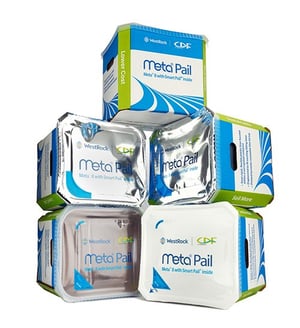Your Package Is as Important as Its Content
Take in this quote by inventor and visionary R. Buckminster Fuller: “We are called to be architects of the future, not its victims.” While that may sound bleak, the ramifications of not actively creating a future does leave us inheriting, by default, whatever one we get. It’s certainly an effective motivator to keep us striving to engineer our visions to fruitful ends.
Planning for a sustainable future in industrial packaging doesn’t need to be approached passively. One good way to maintain a forward-focused mindset is to stay informed on where packaging trends—in this case, food and beverage packaging trends—are heading. It’s as important for B2B companies to understand the consumer mindset as it is for B2C companies—since many customer concerns overlap, and B2C trends strongly influence B2B initiatives.
We like to stay informed and share overall industry intel. It helps us understand what our customers and their end users are facing and expecting. A Bizongo article offers insights about food and beverage packaging trends for 2020. As we know—and as the article states—food packaging as important as the contents. Let’s recap the nine trends highlighted in Bizongo’s article.
9 food packaging trends for 2020:
- Technology-Enabled Solutions
Smart consumers + smart packages—the two go together like peanut butter and jelly! (Sorry, we had to!) NFC chips or QR codes will help educate and inform consumers, while also adding a layer of security to items, helping to avoid another form of “on-the-go” options! Other benefits of smart packaging help producers track elements, such as freshness, pH, temperature, quality, and adherence to safety standards. Pushing the current-day envelope, companies are creating truly interactive packaging. Budweiser provided noise-activated, LED-equipped beer cups at the FIFA 2018 World Cup that lit up the more people cheered. At the 2017 Super Bowl, people enjoying Frito-Lays’ Tostitos were also served up an alcohol sensor, LED lights, and NFC chips to assist them with an Uber ride if they imbibed too much. Interactive and proactive!
- Emotional Engagement
It’s no secret that food elicits emotion—or vice versa, at times. People attach to brands through emotions as well. All the facts on your packaging may inform consumers about what they are consuming, but the message is what connects them with why they are eating or drinking it. Capturing a moment or motivation through your packaging engages them and builds brand loyalty.
- Vintage-Inspired Designs
This piggybacks on the item above—as its appeal is also anchored in emotion. Designs, achieved though graphics, fonts, and matte and pastel colors, evoke a simpler time. According Bizongo, throwback branding even appeals to Millennials, who—as we’ve written about previously—have tremendous buying influence, along with other multi-generational consumers.
- Transparent and Clear Labeling
This probably comes as no surprise: people want transparency … literally. Conscious of what they eat, and indirectly, who and what they support, people want to make informed decisions. Show them what they need to know so they can do that; according to the stats: “38% of consumers are willing to purchase a newly launched product with clear product information.” And to be clear here, they are willing to try a new product when given clear information. Think about how cross-brand loyalty will build once you get them to open that bag of deliciousness or that refreshing beverage.
- Increased Portability
It’s a mobile world—phones, baby monitors, iPads, laptops, and, of course, the drivers of all of this: people. Any time packaging can support a busy lifestyle or appeal to everyday convenience, it’s a win. Whether it’s a “McBike” package created for cyclists to hang food from their handlebars or a coffee cup top molded to accommodate condiments, ease and freedom to feast while on the go should be a given.
- Personalization
Personalization has been a pervasive marketing approach for some time. You may even have come to this blog via an email personalized to you. Because of the proliferation of personalized interactions, consumers may have come to expect it. Bizongo tells us that according to Deloitte Consumer Review, over 50% of Millennials and Gen Z express a desire for personalized products. If you are a smaller producer and need less costly options than massive production runs provide, options are available via custom bags, boxes, and stickers.
- Minimal Designs
Today’s consumers are very well educated. We’re not talking about advanced academic degrees. One word: internet. That means we are all used to doing our research prior to purchasing; it’s as if we are hardwired to remain informed—especially with purchasing decisions. Even if it is an impulse purchase, people are still going to read the label, so make it easy for them: simple, uncluttered, clear labelling and packaging. Here’s something to consider about impulse purchases: a recent survey of U.S. adults by OnePoll for Slickdeals asked respondents about impulse shopping behavior; 71% of respondents indicated that food and groceries are the most popular unplanned products that make their way into shopping carts. Make your products impulse-ready for them! One other added benefit is that simplicity can often lower your packaging costs.
- Gradient Coloring
In a seeming contradiction to the vintage and minimalistic design elements spoken of above, Bozingo says that 70% of consumers find graphics, color, and shape the most attracting aspects of packaging. As with any art, striking a balance in these elements is important, and gradients are a growing trend for their ability to add depth and “intrigue,” as well as attract attention on a crowded shelf.
- Sustainability
According to McKinsey, 80% of consumers are willing to pay the highest green premium in packaging—over mark-ups for electronics, building supplies, automotive, and furniture expenses. Food packaging not only is becoming “greener,” but may, in fact, be green and consumable, as in edible packaging! Biodegradable products and single-use solutions are also growing within the packaging industry.
Of course you want everyone to love your F&B products as much as you do, so appealing to them from their perspective is vital. The global health and wellness food market continues to grow. For lifestyle-conscious consumers looking for better-for-you (BFY) food choices, the packaging must communicate that in facts and function. And for people who just want to feel good about beverages that have their names on the cans while sharing them with their besties—they’re taking it personally, and you’ve done your job.
Our Job
Years ago, we knew there needed to be a change in industrial flexible packaging solutions for food and beverage producers, so we set out to transform traditional packaging. We took it to the next level and designed the disruptive, award-winning Meta® Pail, a semi-rigid, vacuum-formed, plastic pail insert with a hermetically sealed laminated film lid, housed within an 8-sided corrugated Meta container. Meta Pail transports semi-viscous, solid, and most liquid products currently shipped in plastic pails.
We wanted to address the concerns of the entire supply chain—manufacturers, distributors, sales and marketing, customers and end users—because all stages of packaging production, transport, and distribution demand the same performance criteria, such as:
- Food safety
- Extended shelf life
- Ease of use and handling
- Dispensability
- Resealability
- Durability
- Mobility and transport convenience
- Decrease product residual and waste—full evacuation from packaging
- Positive sustainability profile for packaging
Meta Pail’s appeal and functionality extends far beyond simple bullet points, as this article expands upon. It ensures the absolute purity of your product with unique tamper-evident lidding film. The lid film provides an excellent oxygen barrier and is easily peeled and resealable for storage (lidding options are available). This reduces lid costs and contamination.
Meta Pail is suitable for many F&B segments, including:
Solids and dry goods: croutons, diced fruit, frozen fruit, spices, pet food
Semi-Viscous: sauces, dressings, condiments (mayonnaise, pickles, relish), bakery goods (flavorings, fillings, frosting, toppings, puree, compote), and more
Liquids: dairy (yogurt, cheese, ice cream, sweetened condensed milk), dyes, pigments, and more
Meta Pail is also a fantastic solution for chemical, cosmetic, industrial (greases and lubes), and pharmaceutical and medical applications. There’s so much more to discuss about Meta Pail, and this page provides a comprehensive view of this innovative, sustainable packaging solution.
Mindful Packaging
Mindful Packaging is more than a simple concept at CDF. It’s at the heart of our mindset. All our packaging innovations are engineered through this filter, keeping all stakeholders—literally—in mind. Not the least of which is the planet and everyday people, whether or not they ever directly use our industrial packaging products. We take our responsibility to the greater ecosystem seriously and understand that the ripple effects of our actions, large or small, ultimately impact each one of us. And we mind what we do so you don’t have to.
What’s on your mind today; how can we help you meet your flexible, sustainable packaging needs? Contact us now to begin the conversation.

